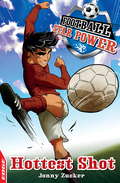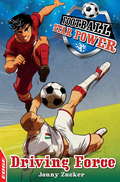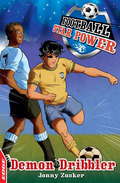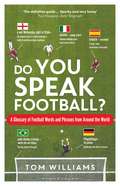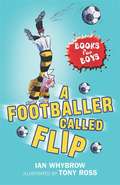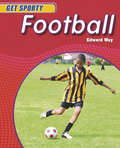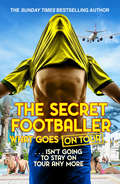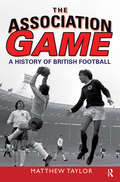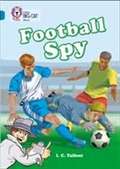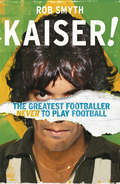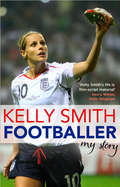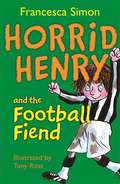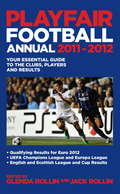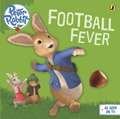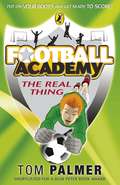Special Collections
Fantastic football!
Description: Football inspired resources - both accessible images and titles - both fiction and non fiction! Aimed at children and young people reading.
- Table View
- List View
Paralympic 7-a-side football (UEB Uncontracted)
byThis page has three images on it: a player trying win the ball from an opponent, a goalkeeper attempting to save a ball, and a diagram showing the layout of a 7-a-side pitch. Players have cerebral palsy or stroke damage of varying severity. Each image has a dashed line image border. There is a locator dot shown, which will be at the top left of the page when the image is the correct way up.A player trying win the ball from an opponent - The image on the top left of the page shows two players and a ball. The player on the left of the image is seen from the side and facing right, so only one eye can be found. He has his arms stretched out to the left and right. He is running, and one leg extends straight to the left. On the right, his other leg is bent with the ball on the ground, just to the right of his foot. The player to the right of the image is seen from the side facing to the left so that only one eye can be found. He has his arms stretched out left and right. His leg to the left is controlling the ball to the left of his foot. To the right his other leg is bent to the right, ready to swing left and kick the ball away from his opponent.A goalkeeper attempting to save a ball - This image, at the bottom left of the page, shows a goalkeeper, a ball and part of the goal net. The goalkeeper has leapt towards the ball, which is in the top left of the image. He has his arms outstretched and his hands are near the ball, ready to catch it. The rest of the keepers body extends diagonally down across the page with both of his legs stretched out in the bottom right of the image. The square grid of the goal net can be found filling the remainder of the image border.Diagram of 7-a-side football pitch - This diagram on the right of the page shows the football pitch and seven members of each team. The players are represented here by large dots and crosses. The pitch is 40 metres wide by 60 metres long. At the top centre of the page there is a small rectangle representing a goal. Down the page from this are the goal area with a goalkeeper, and the penalty area with the penalty spot. Down again is the penalty arc; all players must stay outside of this area when a penalty is being taken. Further down the page are the centre circle, the centre spot, and the centre line going across the image horizontally. At the bottom of the image is the opposing team's goal and penalty area.
Paralympic 7-a-side football (UEB Contracted)
byThis page has three images on it: a player trying win the ball from an opponent, a goalkeeper attempting to save a ball, and a diagram showing the layout of a 7-a-side pitch. Players have cerebral palsy or stroke damage of varying severity. Each image has a dashed line image border. There is a locator dot shown, which will be at the top left of the page when the image is the correct way up.A player trying win the ball from an opponent - The image on the top left of the page shows two players and a ball. The player on the left of the image is seen from the side and facing right, so only one eye can be found. He has his arms stretched out to the left and right. He is running, and one leg extends straight to the left. On the right, his other leg is bent with the ball on the ground, just to the right of his foot. The player to the right of the image is seen from the side facing to the left so that only one eye can be found. He has his arms stretched out left and right. His leg to the left is controlling the ball to the left of his foot. To the right his other leg is bent to the right, ready to swing left and kick the ball away from his opponent.A goalkeeper attempting to save a ball - This image, at the bottom left of the page, shows a goalkeeper, a ball and part of the goal net. The goalkeeper has leapt towards the ball, which is in the top left of the image. He has his arms outstretched and his hands are near the ball, ready to catch it. The rest of the keepers body extends diagonally down across the page with both of his legs stretched out in the bottom right of the image. The square grid of the goal net can be found filling the remainder of the image border.Diagram of 7-a-side football pitch - This diagram on the right of the page shows the football pitch and seven members of each team. The players are represented here by large dots and crosses. The pitch is 40 metres wide by 60 metres long. At the top centre of the page there is a small rectangle representing a goal. Down the page from this are the goal area with a goalkeeper, and the penalty area with the penalty spot. Down again is the penalty arc; all players must stay outside of this area when a penalty is being taken. Further down the page are the centre circle, the centre spot, and the centre line going across the image horizontally. At the bottom of the image is the opposing team's goal and penalty area.
Paralympic 7-a-side football (Large Print)
byThis page has three images on it: a player trying win the ball from an opponent, a goalkeeper attempting to save a ball, and a diagram showing the layout of a 7-a-side pitch. Players have cerebral palsy or stroke damage of varying severity. Each image has a dashed line image border. There is a locator dot shown, which will be at the top left of the page when the image is the correct way up.A player trying win the ball from an opponent - The image on the top left of the page shows two players and a ball. The player on the left of the image is seen from the side and facing right, so only one eye can be found. He has his arms stretched out to the left and right. He is running, and one leg extends straight to the left. On the right, his other leg is bent with the ball on the ground, just to the right of his foot. The player to the right of the image is seen from the side facing to the left so that only one eye can be found. He has his arms stretched out left and right. His leg to the left is controlling the ball to the left of his foot. To the right his other leg is bent to the right, ready to swing left and kick the ball away from his opponent.A goalkeeper attempting to save a ball - This image, at the bottom left of the page, shows a goalkeeper, a ball and part of the goal net. The goalkeeper has leapt towards the ball, which is in the top left of the image. He has his arms outstretched and his hands are near the ball, ready to catch it. The rest of the keepers body extends diagonally down across the page with both of his legs stretched out in the bottom right of the image. The square grid of the goal net can be found filling the remainder of the image border.Diagram of 7-a-side football pitch - This diagram on the right of the page shows the football pitch and seven members of each team. The players are represented here by large dots and crosses. The pitch is 40 metres wide by 60 metres long. At the top centre of the page there is a small rectangle representing a goal. Down the page from this are the goal area with a goalkeeper, and the penalty area with the penalty spot. Down again is the penalty arc; all players must stay outside of this area when a penalty is being taken. Further down the page are the centre circle, the centre spot, and the centre line going across the image horizontally. At the bottom of the image is the opposing team's goal and penalty area.
Paralympic 5-a-side football (UEB Contracted)
byThis page has three images on it: a player trying to stop an opponent passing the ball, two players trying to gain possession of the ball, and a diagram showing the layout of a 5-a-side pitch. All players have sight problems and wear blindfolds. The ball makes a noise to help players locate it and sighted goalkeepers are allowed to shout instructions to players. Each image has a dashed line image border. There is a locator dot shown, which will be at the top left of the page when the image is the correct way up. Player trying to stop an opponent passing the ball. - The image on the top left of the page shows two players and a football. The player to the left is facing to the right, his face in profile and his body twisted so it is facing you. He has his arms extended out to the left and right. One leg is going down the page and left, the other is reaching out to the right and almost touching the ball further right. On the right of the image, an opposing player is facing left with his face in profile and his body turned to face you. His arms reach out to the left and right. He has his foot to the right lifted up, ready to kick the ball and pass it to a teammate.Two players trying to gain possession of the ball - This image, at the bottom left of the page, shows two players and a football. On the left of the image, a player is seen from the side facing right. He has his arms stretched out to the left and right and he is supported on one leg, while his other leg extends out to the right trying to make contact with the ball above. The opposing player on the right of the image is facing left and seen from the side. With his arms stretched out to the left and right, he is running towards the other player to tackle him and try to take possession of the ball.Diagram of a 5-a-side football pitc: This diagram is on the right of the page. The two teams are represented by large dots and crosses. At the top of the image is a goal shown as a small rectangle. Down the page from this is the penalty area and penalty spot. Going across horizontally in the centre of the image, is the halfway line, with the centre spot and centre circle in the middle. The layout in the top of the diagram is mirrored in the bottom. The playing area is 140 feet x 85 feet. The two teams, dots and crosses, have adopted different playing positions. Apart from the last man's in defence near the goal, many teams do not have fixed roles for players. This allows a more fluid game with players reacting to the game as it progresses.
Paralympic 5-a-side football (Large Print)
byThis page has three images on it: a player trying to stop an opponent passing the ball, two players trying to gain possession of the ball, and a diagram showing the layout of a 5-a-side pitch. All players have sight problems and wear blindfolds. The ball makes a noise to help players locate it and sighted goalkeepers are allowed to shout instructions to players. Each image has a dashed line image border. There is a locator dot shown, which will be at the top left of the page when the image is the correct way up. Player trying to stop an opponent passing the ball. - The image on the top left of the page shows two players and a football. The player to the left is facing to the right, his face in profile and his body twisted so it is facing you. He has his arms extended out to the left and right. One leg is going down the page and left, the other is reaching out to the right and almost touching the ball further right. On the right of the image, an opposing player is facing left with his face in profile and his body turned to face you. His arms reach out to the left and right. He has his foot to the right lifted up, ready to kick the ball and pass it to a teammate.Two players trying to gain possession of the ball - This image, at the bottom left of the page, shows two players and a football. On the left of the image, a player is seen from the side facing right. He has his arms stretched out to the left and right and he is supported on one leg, while his other leg extends out to the right trying to make contact with the ball above. The opposing player on the right of the image is facing left and seen from the side. With his arms stretched out to the left and right, he is running towards the other player to tackle him and try to take possession of the ball.Diagram of a 5-a-side football pitc: This diagram is on the right of the page. The two teams are represented by large dots and crosses. At the top of the image is a goal shown as a small rectangle. Down the page from this is the penalty area and penalty spot. Going across horizontally in the centre of the image, is the halfway line, with the centre spot and centre circle in the middle. The layout in the top of the diagram is mirrored in the bottom. The playing area is 140 feet x 85 feet. The two teams, dots and crosses, have adopted different playing positions. Apart from the last man's in defence near the goal, many teams do not have fixed roles for players. This allows a more fluid game with players reacting to the game as it progresses.
Hottest Shot
by Jonny ZuckerLeo's football skills are...well let's just say he's not his team's star player. But when he visits a football museum everything changes in a flash. He can talk to football superstars - and they help to coach him!In Hottest Shot, Leo is transported to Geoff Hurst's past where he is given shooting tips by the England World Cup winner himself! Leo has to learn fast, because before he's ready he has to help Geoff beat West Germany at the 1966 World Cup Final.A fantasy football tale from another dimension!This title is published by Franklin Watts EDGE, which produces a range of books to get children reading with confidence. EDGE - for books children can't put down.
Driving Force
by Jonny ZuckerLeo's football skills are...well let's just say he's not his team's star player. But when he visits a football museum everything changes in a flash. He can talk to football superstars - and they help to coach him!In Driving Force, Leo is transported to Steven Gerrard's childhood home in Liverpool where he is given tips on how to drive an attack forward. Leo has to learn fast, because before he's ready he has to help Steven fight back against Milan in the 2005 Champions League Final - and Liverpool are 3-0 down! A fantasy football tale from another dimension!This title is published by Franklin Watts EDGE, which produces a range of books to get children reading with confidence. EDGE - for books children can't put down.
Demon Dribbler
by Jonny ZuckerLeo's football skills are...well let's just say he's not his team's star player. But when he visits a football museum everything changes in a flash. He can talk to football superstars - and they help to coach him!In Demon Dribbler, Leo is transported to Brazil where he is coached on a beach by Pelé, the world's greatest football player. He picks up some skills, and then actually helps Pelé out in the 1970 World Cup Semi-Final. A fantasy football tale from another dimension!This title is published by Franklin Watts EDGE, which produces a range of books to get children reading with confidence. EDGE - for books children can't put down.
Do You Speak Football?
by Tom Williams'At last, the definitive guide to football phraseology across the world... Sparky and very funny.' Paul Hayward, Daily Telegraph''Amusing and informative in equal measure.' Oliver Kay, The TimesAn expertly compiled and utterly fascinating compendium of the weird and wonderful words and phrases used to describe football around the world.To speak football is to speak a language of a thousand tongues…In this ground-breaking global glossary of football words and phrases, you'll discover the rich, quirky and joyously creative language used by fans, commentators and players across the world.From placing a shot 'where the owl sleeps' in Brazil, to what it means to use your 'chocolate leg' in the Netherlands, via Wembley-Tor – a phrase adopted by Germans to describe a dubious goal – this comprehensively researched book will entertain and inform in equal measure.Discover the unfortunate Finnish term for a holding midfielder, what it means when South Korean fans get nostalgic about a 'Leeds season' and why Dundee United supporters should keep their heads down in Nigeria.With over 700 terms from 89 countries (including 29 ways to describe a nutmeg), this is the definitive guide to the global language of football.
Books For Boys, Book 2
by Ian WhybrowJack is short. So short in fact that Mr Bullock doesn't want him on the St Saviours football team. But when Mr Willis discovers Jack's footballing brain, and Jack's mum steps in with a few tips, it looks like the School Cup may be just the beginning.
Football
by Edward WayThis book tells you all you need to know to help you start playing football. Step-by-step photos will show you the moves you'll need, there are top tips on improving your game and pro play panels show top players demonstrating their skills in matches.
The Secret Footballer
by The Secret FootballerSince his first book was published in 2012, The Secret Footballer has been able to take the reader behind the scenes of footballers' lives like no other player has been able, or will ever be able, to do. Anonymity has been a potent weapon in revealing the real world of football stars, and five years on, he has now penned the work that all his fellow professionals have been urging him to do from the start, The Secret Footballer: What Goes on Tour. And it isn't going to stay on tour any more...From Marbella and Ibiza to Dubai and Las Vegas, The Secret Footballer lays bare the worst, most embarrassing and most hilarious excesses of these fit and mostly fickle young men whose million-pound salaries, to use his own words, 'open up a host of recreational opportunities'. Fuelled by rampaging desires for sex, drugs, booze and rock'n'roll, these footballers think up ever more extreme ways of splashing the cash, and needless to say, it doesn't always end well...
The Association Game
by Matthew TaylorThe story of British football's journey from public school diversion to mass media entertainment is a remarkable one. The Association Game traces British football from the establishment of the earliest clubs in the nineteenth century to its place as one of the prominent and commercialised leisure industries at the beginning of the twenty first century. It covers supporters and fandom, status and culture, big business, the press and electronic media and development in playing styles, tactics and rules. This is the only up to date book on the history of British football, covering the twentieth century shift from amateur to professional and whole of the British Isles, not just England.
Collins Big Cat, Band 13, Topaz
by I. C. TallentDo you know what it takes to be a top footballer? Can you pick out the best moves? Find out in this guide to football skills. It will help children to understand how to study a football game and how to look for the skills of different types of players: goalkeepers, defenders, midfielders and strikers.Topaz/ Band 13 books offer longer and more demanding reads for children to investigate and evaluate.
Collins Big Cat, Band 13, Topaz
by I. C. TallentDo you know what it takes to be a top footballer? Can you pick out the best moves? Find out in this guide to football skills. It will help children to understand how to study a football game and how to look for the skills of different types of players: goalkeepers, defenders, midfielders and strikers.Topaz/ Band 13 books offer longer and more demanding reads for children to investigate and evaluate.
Kaiser
by Rob Smyth1980s Rio de Janeiro.There’s only one king in this city and he’s got the mullet, swagger and fake ID to prove it.Introducing Carlos Henrique Raposo, known to all as KAISER.This guy’s got more front than Copacabana beach. He’s the most loveable of rogues with the most common of dreams: to become a professional footballer. And he isn’t about to let trivial details like talent and achievement stand in his way. . . not when he has so many other ways to get what he wants.In one of the most remarkable football stories ever told, Kaiser graduates from abandoned slumdog to star striker, dressing-room fixer, superstar party host and inexhaustible lover. And all without kicking a ball. He’s not just the king… he’s the Kaiser.
Footballer
by Kelly SmithAll Kelly Smith ever wanted to be was a footballer. Blessed with brilliant talent which she honed with hours of practice, it was soon clear to all who saw her that Kelly was the best women’s footballer that this country had ever produced. Yet for this shy girl from Watford, it would be a long and difficult journey to the pinnacle of the world game, and one which would involve the hardest of challenges.After starting drinking to mask her loneliness thousands of miles from home in the United States, a series of career-threatening injuries led to severe depression and a battle with alcoholism. But with the fighting spirit that was so essential on her path to be Britain’s first women’s professional player, Kelly bounced back to inspire Arsenal to countless trophies and become England’s record goalscorer.Footballer: My Story is the inspirational tale of a woman with a drive to succeed. It is the unique inside story of a star in a sport enjoyed by millions yet often not granted the recognition it deserves. And as she nears the end of a glittering playing career, it is the story of how Kelly Smith became what she always wanted to be. A professional footballer, in a professional league.
Horrid Henry and the Football Fiend (PDF)
by Francesca SimonHorrid Henry reads Perfect Peter's diary and improves it. He goes clothes shopping with Mum and tries to make her buy him some Rootatoot trainers. He is horrified when his old enemy Bossy Bill turns up at school. And he tries by any means, fair or foul, to win the class football match and defeat Moody Margaret.
Horrid Henry and the Football Fiend
by Francesca SimonHorrid Henry reads Perfect Peter's diary and improves it. He goes clothes shopping with Mum and tries to make her buy him some Rootatoot trainers. He is horrified when his old enemy Bossy Bill turns up at school. And he tries by any means, fair or foul, to win the class football match and defeat Moody Margaret.
Playfair Football Annual 2011-2012
by Glenda Rollin and Jack RollinThe factual, concise and first-choice guide for the real fan. Now in its 64th year, PLAYFAIR FOOTBALL ANNUAL includes all the Champions League and Europa League details; a compact directory for English and Scottish clubs; English and Scottish league and cup match results; and stats on how English league clubs have fared over the last 25 years. A pocket-size treat - this is the ideal book to take to matches and settle arguments before, during and after!
Football (UEB uncontracted)
by RnibThis page has three images on it: a player about to kick the ball past an opponent, a goalkeeper attempting to save a ball, and a diagram showing the layout of a football pitch. Each image has a dashed line image border. There is a locator dot shown, which will be at the top left of the page when the image is the correct way up. A player about to kick the ball past an opponent: The image on the top left of the page shows two players and a ball. The player on the left of the image is seen from the side and facing right, so only one eye can be found. He has his arms stretched out to the left and right. He is running, and one leg extends straight to the left. On the right, his other leg is bent up slightly. He wears a red shirt and white shorts (large print copy). The player to the right of the image is seen from the side facing to the left so that only one eye can be found. He has his arms stretched out and down to left and right. He stands on the leg to the left. To the left the ball sits on the grass. To the right his other leg is bent to the right, ready to swing left and kick the ball past his opponent. He wears a black and white striped shirt and black shorts (large print copy). A goalkeeper attempting to save a ball: The image at the bottom left of the page shows a goalkeeper, a ball and the goal. The goalkeeper has leapt off the ground towards the ball, which is in the top left of the goal. He has his arms outstretched and his hands are near the ball, ready to catch it. The rest of the keeper's body extends diagonally down and right. The square grid of the goal net can be found filling the goal posts behind him. Diagram of a football pitch: This diagram on the right of the page shows the football pitch and eleven members of each team. The players are represented here by large dots and crosses. At the top centre of the page there is a small rectangle representing a goal. Down the page from this are the goal area with a goalkeeper, and the penalty area rectangle with the penalty spot. Down again is the penalty arc, a semi-circle; all players must stay outside of this area when a penalty is being taken. Further down the page are the centre circle, the centre spot, and the centre line going across the image horizontally. At the bottom of the image is the opposing team's goal and penalty area. The pitch is on average 115 yards long x 75 yards wide (106 x 70 metres). Pitches, even in the Premier League, vary slightly across the country. Before the match starts and after a goal has been scored the players position themselves in various formations. The team at the top of the page is in 4:3:3 formation. That is four forwards, three mid-fielders and three defenders. The team at the bottom are in 4:4:2 formation, four forwards, four mid-fielders and two defenders. There are many other possibilities but these are some of the commonest.
Football (UEB contracted)
by RnibThis page has three images on it: a player about to kick the ball past an opponent, a goalkeeper attempting to save a ball, and a diagram showing the layout of a football pitch. Each image has a dashed line image border. There is a locator dot shown, which will be at the top left of the page when the image is the correct way up. A player about to kick the ball past an opponent: The image on the top left of the page shows two players and a ball. The player on the left of the image is seen from the side and facing right, so only one eye can be found. He has his arms stretched out to the left and right. He is running, and one leg extends straight to the left. On the right, his other leg is bent up slightly. He wears a red shirt and white shorts (large print copy). The player to the right of the image is seen from the side facing to the left so that only one eye can be found. He has his arms stretched out and down to left and right. He stands on the leg to the left. To the left the ball sits on the grass. To the right his other leg is bent to the right, ready to swing left and kick the ball past his opponent. He wears a black and white striped shirt and black shorts (large print copy). A goalkeeper attempting to save a ball: The image at the bottom left of the page shows a goalkeeper, a ball and the goal. The goalkeeper has leapt off the ground towards the ball, which is in the top left of the goal. He has his arms outstretched and his hands are near the ball, ready to catch it. The rest of the keeper's body extends diagonally down and right. The square grid of the goal net can be found filling the goal posts behind him. Diagram of a football pitch: This diagram on the right of the page shows the football pitch and eleven members of each team. The players are represented here by large dots and crosses. At the top centre of the page there is a small rectangle representing a goal. Down the page from this are the goal area with a goalkeeper, and the penalty area rectangle with the penalty spot. Down again is the penalty arc, a semi-circle; all players must stay outside of this area when a penalty is being taken. Further down the page are the centre circle, the centre spot, and the centre line going across the image horizontally. At the bottom of the image is the opposing team's goal and penalty area. The pitch is on average 115 yards long x 75 yards wide (106 x 70 metres). Pitches, even in the Premier League, vary slightly across the country. Before the match starts and after a goal has been scored the players position themselves in various formations. The team at the top of the page is in 4:3:3 formation. That is four forwards, three mid-fielders and three defenders. The team at the bottom are in 4:4:2 formation, four forwards, four mid-fielders and two defenders. There are many other possibilities but these are some of the commonest.
Football (large print)
by RnibThis page has three images on it: a player about to kick the ball past an opponent, a goalkeeper attempting to save a ball, and a diagram showing the layout of a football pitch. Each image has a dashed line image border. There is a locator dot shown, which will be at the top left of the page when the image is the correct way up. A player about to kick the ball past an opponent: The image on the top left of the page shows two players and a ball. The player on the left of the image is seen from the side and facing right, so only one eye can be found. He has his arms stretched out to the left and right. He is running, and one leg extends straight to the left. On the right, his other leg is bent up slightly. He wears a red shirt and white shorts (large print copy). The player to the right of the image is seen from the side facing to the left so that only one eye can be found. He has his arms stretched out and down to left and right. He stands on the leg to the left. To the left the ball sits on the grass. To the right his other leg is bent to the right, ready to swing left and kick the ball past his opponent. He wears a black and white striped shirt and black shorts (large print copy). A goalkeeper attempting to save a ball: The image at the bottom left of the page shows a goalkeeper, a ball and the goal. The goalkeeper has leapt off the ground towards the ball, which is in the top left of the goal. He has his arms outstretched and his hands are near the ball, ready to catch it. The rest of the keeper's body extends diagonally down and right. The square grid of the goal net can be found filling the goal posts behind him. Diagram of a football pitch: This diagram on the right of the page shows the football pitch and eleven members of each team. The players are represented here by large dots and crosses. At the top centre of the page there is a small rectangle representing a goal. Down the page from this are the goal area with a goalkeeper, and the penalty area rectangle with the penalty spot. Down again is the penalty arc, a semi-circle; all players must stay outside of this area when a penalty is being taken. Further down the page are the centre circle, the centre spot, and the centre line going across the image horizontally. At the bottom of the image is the opposing team's goal and penalty area. The pitch is on average 115 yards long x 75 yards wide (106 x 70 metres). Pitches, even in the Premier League, vary slightly across the country. Before the match starts and after a goal has been scored the players position themselves in various formations. The team at the top of the page is in 4:3:3 formation. That is four forwards, three mid-fielders and three defenders. The team at the bottom are in 4:4:2 formation, four forwards, four mid-fielders and two defenders. There are many other possibilities but these are some of the commonest.
Peter Rabbit Animation
by Beatrix PotterEveryone has gone football crazy! It's rabbits versus squirrels. But surely squirrels can't play football, can they...? Peter Rabbit and his friends have hit the screen on CBeebies and everybody wants to join Peter Rabbit's club! So much more than a story - study the map, enjoy the adventure then complete Peter's special skill challenge.
Football Academy
by Tom PalmerUnited's under-twelves are in Poland for a tournament. Goal-keeper Tomasz is very excited to be playing in his home country, but team captain Ryan thinks Poland are rubbish - in fact, he thinks everything Polish is rubbish. Ryan's behaviour causes trouble both on and off the pitch. Can Ryan and Tomasz tackle their differences - or will Ryan's bullying foul United's chance of success?

